OLGA ROMANOV: GRAND DUCHESS OLGA NIKOLAEVNA OF RUSSIA
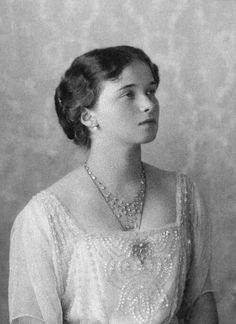
A very large baby girl joined the Romanov family on November 15 (Old Style: November 3) 1895, in St Petersburg, Russia. On that day her father, Tsar Nicholas II, wrote in his diary: “A day I will remember forever . . . at exactly 9 o’clock a baby’s cry was heard and we all breathed a sigh of relief! With prayer we named the daughter sent to us by God ‘Olga’!”
Baby Olga’s aunt, the Grand Duchess Ksenia’s diary entry for 3 November was a bit more cynical: “The birth of a daughter to Nicky and Alix! A great joy, although it’s a great pity it’s not a son! . . . The baby is huge – weighing 10 pounds – and had to be pulled out with forceps!”
Grand Duchess Olga Nikolaevna Romanov was the first of Tsar Nicholas II’s and Tsarina Alexandra Feodorovna’s five children. Born at the Anichkov Palace where the newlywed Russian imperial couple initially settled, the first of four daughters, Olga Romanov was born “in the purple” – during the imperial reign of her parents. Her Russian title “Velikaya Knyazhna” is most precisely translated as “the Grand Princess”, which means that Olga Romanov, as an “Imperial Highness”, was higher in rank than other princesses in Europe who were merely “Royal Highnesses”. “Grand Duchess” is the more common English translation.
Olga’s mother Empress Alexandra startled her own grandmother, Queen Victoria of England, by insisting on breastfeeding her firstborn, which was quite unusual for aristocratic, let alone royal, women in the 19th century. Olga was the only one of her siblings to meet in person her formidable English great-grandmother, who was also one of her godmothers. The tiny grand duchess was probably too young to remember her visit to the British court since it occurred during the family’s trip abroad when she was just an infant. Empress Alexandra, known to her family as Alix, was one of Queen Victoria’s favorite granddaughters. Victoria was delighted to meet her new great-granddaughter and spend time with her, posing for numerous photos.

As Olga grew into a toddler in 1897, she became the big sister to another imperial daughter, Tatiana. In 1898, the growing family finally moved away from Nicholas’s childhood home, the Anichkov Palace in St Petersburg, where they resided with Olga’s grandmother, the Dowager Empress. They made the relatively intimate Alexander Palace in Tsarskoe Selo (literally translated as “Imperial Village”, a St Petersburg suburb) their permanent home. In another year, Olga was joined by yet another baby sister, Grand Duchess Maria Nikolaevna.
In 1901, just before Olga and her family went to Peterhof, a seaside town on the Gulf of Finland founded by Peter the Great, for the summer holiday she came down with typhoid fever. This was the same disease that killed Grand Duchess Olga’s great-grandfather Prince Albert, Queen Victoria’s consort.
The six-year-old grand duchess, seriously ill for five long, weary weeks, was nursed by her mother and her governess, Margaret Eagar. For a while it seemed that Olga might not recover, but fortunately she did. Olga was still in bed when her fourth sister Anastasia was born. Little Olga was disappointed by not being able to attend the new baby’s baptism, which would have been her first “official” ceremony.

As the Romanov family kept expanding Olga’s parents did their best to provide “normal” lives for their little girls. Just like any Russian family they celebrated Orthodox holidays such as Christmas by exchanging gifts and decorating a fir tree. Mrs. Eagar, who had been the girls’ governess since 1898, remembered one particular Christmas when the little girls were delighted to see their mother gorgeously attired for a ceremony. They circled around her in speechless admiration when suddenly the Grand Duchess Olga clapped her hands, and exclaimed fervently, “Oh! Mama, you are just like a lovely Christmas tree!”
The Romanov children used to make Christmas and birthday presents for their parents with their own hands, generally needlework. One Christmas, despite Mrs. Eagar’s attempts to convince her otherwise, Grand Duchess Olga insisted on making a kettle-holder for her father. It had a picture of a little kettle singing on a fire, which she embroidered around as a blue frame, and the little girl was very happy with her accomplishment. When Christmas came, she presented it to her father Nicholas II, saying, “Nanny was afraid that it wasn’t going to be much use to you because it’s a kettle-holder, but you can put it on your table and use it as a place mat, or hang it on the wall for a picture. Just see the pretty little frame around it.”

From the many intimate anecdotes of her governess, we get a glimpse of Olga Romanov’s mentality as a little girl. Especially revealing is Olga’s attitude about her status as the oldest imperial sibling. The little grand duchess was always profoundly interested in biblical stories, like the one of Joseph and his brothers. After Mrs. Eagar pronounced how terrible it was for the brothers to be so jealous and so cruel to their youngest sibling, Olga responded, “It was a shame of the father [sic]. Joseph was not the eldest, and the beautiful coat should have been given to the eldest son; the other brothers knew that, and perhaps that was why they put him in the pit.” All explanations were useless – Olga’s sympathies lay with Joseph’s eldest brother Reuben.
A similar incident occurred when a cinematograph was played for the children and some friends. The film showed two little girls playing in a garden, when an older girl snatched a toy from the little one, who refused to give it up. Foiled in her attempts, the elder girl seized a spoon and pounded the little one with it, which made the latter quickly relinquish the toy and begin to cry. Grand Duchess Tatiana was upset and weeping to see the poor little girl so ill-treated, but Olga said, “I am sure that the toy belonged at first to the big sister, and she was kind and lent it to her sister; then she wanted it back, and the little sister would not give it up, so she had to beat her.”
When “Alice in Wonderland” was first read to Grand Duchess Olga, the little girl was horrified at the manners of the queens. “No queens,” Olga said, “would ever be so rude.” From books and stories Olga was also able to learn about some things about the outside world that she had never experienced firsthand. When the “Alice in Wonderland” chapter about Alice’s journey by railway was read to her, she was very amused that Alice did not have the train compartment all to herself. It was explained to her that each person had to buy a ticket and occupy just one seat in the train, with some tickets costing more than others and the highest-priced tickets granting a better place in the train. Still bemused, Grand Duchess Olga asked, “When you travel, can anyone with the same kind of ticket you have get into the same carriage as you do?” No matter how “normal” her parents tried to make Olga’s life, there were many mundane things that most people took for granted that were completely foreign concepts to the little girl.
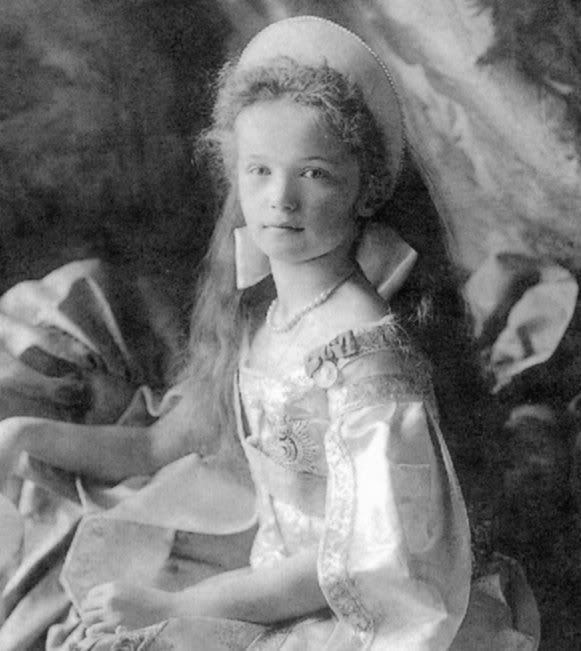
In 1904, the long awaited birth of a male heir Alexei Nikolaevich to the Russian throne took place, to the elation of the imperial family and of the entire nation. Hence, Olga finally got the chance to participate in her first grand ceremony at the baptism of baby brother Alexei. But tragically, the little boy who was destined to become the next tsar of Russia was born with the fatal medical condition: hemophilia. Tsesarevich Alexei inherited this rare and untreatable blood disorder from his mother. It had been passed down genetically to Tsaritsa Alexandra from her mother, Princess Alice of England, who in turn had received it from her own mother, Queen Victoria. The Russian heir’s condition brought the tight-knit imperial family even closer together, but was also understandably a source of severe anxieties and despair for Olga’s parents. Desperation over Tsesarevich Alexei’s hemophilia also contributed to the Tsar’s and Tsarina’s dependence on the reputation of the charismatic Siberian peasant Grigori Rasputin as a faith healer – a factor of major historical significance. As for Olga, she loved her little brother unconditionally, as did all Alexei’s other sisters, and felt intensely protective of him.
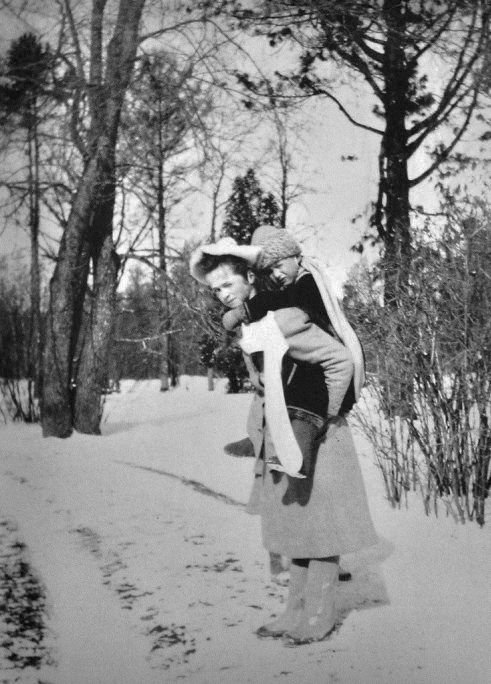
Even as a child Olga Romanov tended to be the most reflective and analytical of her siblings. When she was 8 years old, the war between Russia and Japan broke out in 1904. All the girls, even the 3-year-old Anastasia, worked hard at frame knitting, making scarves for the soldiers, and the two eldest girls also crocheted caps. One day Olga, diligently at work on her crocheting, suddenly said to Mrs. Eagar, “I hope the Russian soldiers will kill all the Japanese; not leave even one alive.” When the governess explained that there were many innocent little children and women in Japan, people who could not fight, Olga reflected for a moment, and then asked her if they also had an Emperor in Japan, and hearing that they did, she continued to ask various other questions about Japan. Upon some thoughtful reflection, Olga finally said slowly, “I did not know that the Japs were people like ourselves. I thought they were only like monkeys.” After that conversation, Olga never again said anything about being pleased to hear of the deaths of the Japanese.

When she started to read herself, one of Olga’s favorite subjects were stories about medieval European history. According to Margaret Eagar, Olga once read a story about the execution of the Welsh Prince Llewellyn. The English beheaded him, sending his head to London, which made a great impression on the little girl. She was terribly shocked, and exclaimed, “It was a good thing he was dead before they cut off his head; it would have hurt him most awfully if he was alive.” The governess explained that they were not always so kind and usually cut the heads off living people, to which Olga replied, “I really think people are much better now than they used to be. I’m very glad I live now when people are so kind.”
According to her governess, Olga was taught by masters of music as well as Russian and mathematics. Once her arithmetic master, who was a professor of algebra from one of the universities, assigned Olga to write something; she asked his permission to go see the Russian master, who was teaching the Grand Duchess Tatiana in the next room. When asked why she needed to see him, Olga told him that she wanted to ask him how to spell “arithmetic.” The math teacher then spelled this difficult word for her, to which she declared with great admiration, “How clever you are! And how hard you must have studied to be able not only to count so well but to spell such very long words!”
Pierre Gilliard, the grand duchesses’ French tutor, described his first meeting with Olga Nikolaevna: “The eldest of the Grand Duchesses, Olga, a girl of about ten, [was] very blonde, with eyes full of mischief, and a slightly retroussé little nose; [she] was studying me with an expression that seemed like an attempt to find my weakest point – however, from this child emanated such feeling of purity and sincerity that she immediately gained my sympathy.”
Olga Romanov was always described as the most intelligent and studious of all the imperial siblings, but at the same time the most prone to deep reflection and self-analysis, even melancholy.

Due to her mother’s frequent illnesses and dislike of public events, it often fell to Grand Duchess Olga, as she grew older, to perform the duties that the Tsar’s consort would usually do. Of the imperial children, Olga was closest to her father, but she loved both her parents profoundly, as is evident from her diaries. Although she reportedly had occasional differences of opinion with her mother, Olga was fiercely defensive and greatly sympathetic towards her, especially when it came to Tsarina Alexandra’s health.
Much like her father, Tsar Nicholas II, Olga loved taking long walks in the parks of Tsarskoe Selo. She often said that she would love someday to live in a small village because she loved nature so much more than the city. Olga also loved to sail on the imperial yacht “Standart”, and enjoyed the annual summer trips to the Black Sea in the Crimea, as well as other family holidays to Finland and Poland.

As Olga Romanov got older, in addition to her love of nature and the outdoors, she became an even more voracious reader of books: the classics, the history of Russia and works detailing the lives of the peasants, ancient traditions, customs, laws, and geography of her nation. She had an extraordinary memory. According to Meriel Buchanan, the daughter of one of the British ambassador in Russia, Olga never forgot anything that she learned or what she had been told. Olga also loved music and was an excellent pianist.
Along with her siblings, Grand Duchess Olga had keen interest in the lives and problems of others. It was she who once noticed a disabled little girl in one of the keepers’ cottages in the park at Tsarskoe Selo and insisted on becoming the child’s “patron.” She made arrangements for the child to be transported to a hospital, and planned on paying for it out of her own allowance.
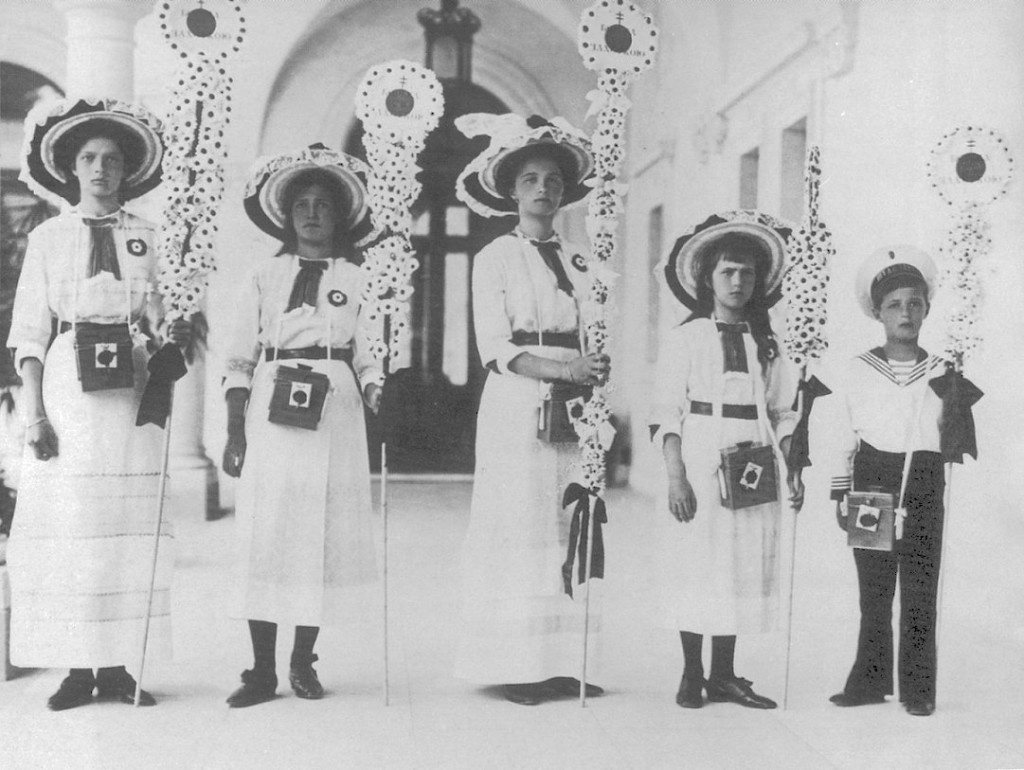
Neither Olga nor any of her siblings ever bought their own clothes or anything else for themselves. The small allowances they received always went towards little presents to their parents or members of their household. Hence Olga had very little knowledge or idea of the value of money.
In her memoirs, Meriel Buchanan describes the physical appearance of the 15-year-old Olga at an imperial ball in 1910: “That evening … she wore a pale-pink chiffon dress of almost classical simplicity, a silver ribbon was bound round her golden hair, which was parted in the middle, and her only jewels were a string of pearls round her slender neck. She had not the regular features, the almost mystical beauty of her sister, Tatiana Nikolaievna, but with her rather tip-tilted nose, her wide laughing mouth, her sparkling blue eyes, she had a charm, a freshness, an enchanting exuberance that made her irresistible.”
In November of 1911 Olga Romanova was turning 16, which was considered the coming of age for Russian aristocratic girls. Every young girl impatiently awaited this event as it was the time of her first “grown up” ball, her coming out to the world. A grand dinner and gala party was taking place on that day at the Palace in Livadia at the Crimea, to celebrate Grand Duchess Olga’s landmark event.
Those who received the following invitation considered it a great honor: “Their Imperial Majesties invite[You] to dinner and a dancing party to be held on Thursday November 3rd, at 6:45 in the evening, at the Livadia Palace.” Dress for the occasion was strictly regulated: “Military cavaliers in frock coat with epaulets… Civilians in evening dress with white tie. 1911”
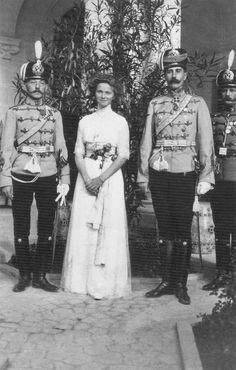
General Alexander Spiridovich, the Chief of Secret Personal Police in charge of protecting Nicholas II and his immediate family from 1905 until 1914, described the gala: “Dinner was served on small tables. Many candles, silver, flowers. At the round table in the center were seated Their Majesties, Grand Dukes Nicholas Nikolaevich, Pierre Nikolaevich, Alexander Mikhailovich, George Mikhailovich, with their wives, and the Minister of the Court. The star of the party, Olga Nikolaevna, in a pink dress, for the first time with her hair in a chignon, presided over the table. Her escort was N.P. Sablin. Still a young girl, very naïve, she often asked her escort what she should do… All flushed in the face, charming in her pink dress, Olga Nikolaevna literally beamed with joy at the great favor accorded to her regiment [The 9th Hussar regiment of Elizavetgrad, of which Olga was the chief]. They congratulated her and kissed her hand. ”
Unlike her sister Maria, Grand Duchess Olga did not often talk about wanting a large family, a husband and lots of children. However, it is evident from her diaries that she was a very romantic girl, who often idealized the young men she developed crushes on. During the winter of 1913-14, after Olga just turned 18, several royal young men were considered as potential husbands for her. Among them were her cousin Grand Duke Dimitri; Prince Arthur of Connaught; the Duke of Leuchtenberg; and even briefly Edward, the Prince of Wales.
When the Crown Prince and Princess of Romania visited Russia, they brought along their eldest son Prince Carol, and everyone anxiously awaited the announcement of his and Olga’s engagement. The Romanian royals stayed at Tsarskoe Selo for several days, but in the end nothing came of this venture. The grand duchess and the prince evidently did not “click”. Olga mentioned this visit briefly in her diary, and the impression we get is disinterest at best.
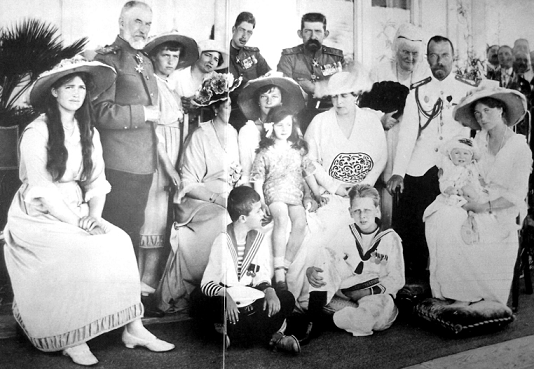
The two respective royal families did not, however, completely give up on the idea of the marriage, and that summer Olga and her parents boarded the Standart and sailed to Constantza, Romania. Clearly, Olga was too smart not to figure out the reason for this journey. She mentioned to Pierre Gilliard that she was aware that everyone was hoping for the Romanian engagement, but that her father had promised her that she would not be forced into a marriage that was distasteful to her.
See original footage of the photograph on the left
Diplomatically, Olga never actually said that she did not like the Romanian prince as potential husband. Instead, she insisted that the reason she did not want this marriage was because she did not wish to leave her beloved Russia or change her nationality, as she would be forced to do if she married Prince Carol. The idea of the Romanian marriage was eventually abandoned and Olga remained unmarried. And as Russia embarked on the World War later that summer, there was no more talk of marriage.

The coming of war marked a great change in Olga’s life. Instead of the social activities and balls of peacetime, Olga and Tatiana joined their mother in training as military nurses or “Sisters of Mercy.” Working together in their contribution to the Russian war effort no doubt strengthened the strong sisterly “We 2” bond between Olga and Tatiana.
After August of 1914, Olga’s diaries are full of her impressions and thoughts about the infirmary that was set up at the Catherine Palace in Tsarskoe Selo, which was the sisters’ own hospital, and of course about the patients themselves. The two younger sisters Maria and Anastasia had their own separate infirmary, however they were too young to officially train as Sisters of Mercy.
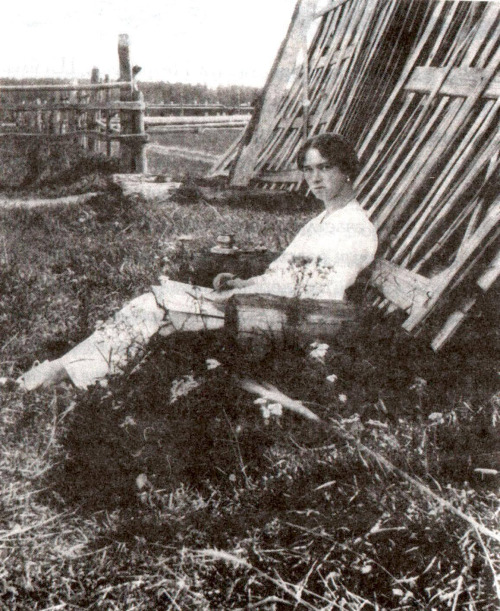
In the twilight of 1916, events turned progressively dismal for Olga and her family. Meriel Buchanan wrote: “Spending her days working in the hospital, butting for the wounded, caring for her brother who had fallen ill again after a visit to Headquarters, the Grand Duchess Olga saw her mother daily more exhausted, more strained, more unhappy, and eventually overwhelmed with grief when Rasputin was murdered on December 16, 1917.”

According to Buchanan, “[Olga] was keenly aware of the growing menace and dangers of the situation. ‘Why has the feeling in the country changed against my father?’ she asked a lady-in-waiting, and then the latter replied that to explain that it would be necessary to go back to the reign of her grandfather who had countermanded all the progressive, constitutional plans of her great-grandfather Alexander II. She was silent and pensive, not entirely satisfied perhaps, wondering if there were not more ominous reasons for the unrest and ferment that she sensed rather than knew about, but which filled her with a growing anxiety.”
Olga Romanov’s life ended tragically before her 23rd birthday, when she and the entire Romanov family were brutally murdered in the cellar of the Ipatiev house in Ekaterinburg.
Leave a comment